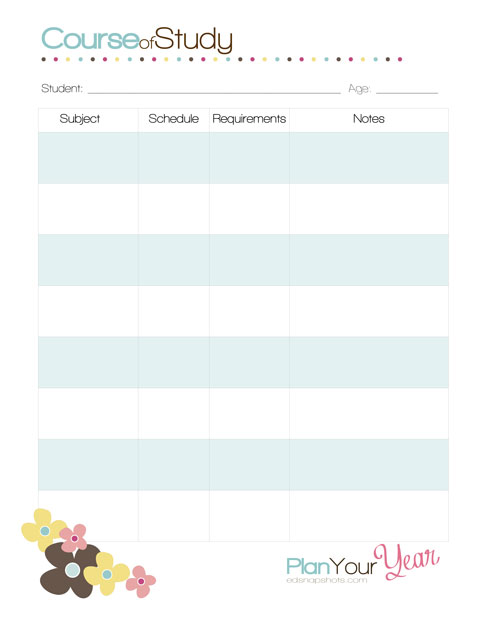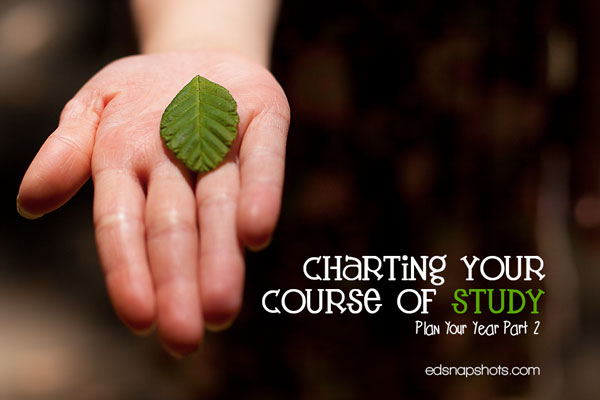This post is the part two in a series on how to plan your homeschool year. You can view part one here. I will be using the forms in my free Plan Your Year homeschool planning pack. Click on over and download your free copy so we can get started!
Once goals have been decided, the next step in planning a homeschool year is to determine what you are going to study. How you go about this will be determined by many factors.
For some, the state may require that they study certain subjects. Others will be committed to a method of education, like Charlotte Mason or Classical which will cause them to include particular subjects in their curriculum. However, the most important factor is simply that you intentionally determine what course of study is best for your family.
Before you add a subject to your subject list, be sure that you have evaluated your reasons for studying it. Why are you learning cursive? What is the purpose of a foreign language in the elementary years? Does your first grader really need a full science and history curriculum on top of a focus on reading, writing and basic mathematics?
Knowing why you are doing a subject will help you determine if you need to stick with it or abandon it if the going gets tough. Thinking through your reasons will help you avoid making curriculum decisions based on comparisons or peer pressure.
Start by considering what subjects you need to and would like to study. Math is a given for all lower grades. A systematic study and practice of mathematics helps cement mathematical concepts and those all-important math facts.
Reading instruction should continue until reading fluency and skills are developed and strong independent reading emerges. After that, it is not necessary to continue using graded readers and comprehension questions. Instead focus on an independent reading list of children’s classics and modern quality literature.
Model your own good reading habits — questioning, making inferences, and predicting — out loud as you read aloud, so that your student will learn to do that in their own silent reading. Finally, require silent reading time each day. Instead of worksheets or book reports, you might substitute narration and discussion to evaluate comprehension.
Spelling instruction, handwriting, grammar, and writing instruction round out the language arts program. There are various ways that these subjects can be integrated, though, to avoid a litany of workbooks.
In our home we use a separate reading and spelling program, but the spelling includes dictation and the reading includes language study. Latin also serves as a grammar and vocabulary program, and as of third grade we have yet to be consistent with a formal writing program.
Every single skill does not have to be done every year — there is so much cross-over in the area of language, especially when you focus on quality literature and discussion.
Additionally, memorization is a large part of our own homeschool. It trains the memory to retain more information and the easy recall of lower-level, factual material is vital in releasing the working part of the brain to participate in higher-level thinking instead of mere recall.
Science, history, and unit study-type activities are pleasant additions to the elementary curriculum, but not entirely necessary. Don’t underestimate the importance of the enjoyment students derive from these subjects.
They also provide an opportunity for creating pegs for later learning and for practicing beginning research and writing skills. They should not, however, be done at the sacrifice of basic skills.
Your family faith and culture will also determine how much time you spend on subjects like religion, Bible study, art, fine arts appreciation, and poetry.
Middle school is a time to spend fostering greater independence and expanding on a student’s critical thinking skills. The student’s tendency to question everything at this age can be channeled into interesting discussions of literature and deeper study of content subjects. Skills in writing and mathematics can be cemented, while the student is now becoming developmentally ready to succeed at subjects like pre-algebra and sentence diagramming.
Finally, for most, high school will be spent preparing the student for college or career and meeting graduation requirements. Work closely with state requirements or the colleges of your choice to be sure your teen is meeting the standards required for diploma and admission, and allow the student to spend time focusing on passions, including vocational interests and life skills.
I would encourage you to approach transcript making creatively, to allow the student the freedom to explore and learn about the topics that interest them the most. There’s more than one way to earn a science, history, or American literature credit.

Next there is a space for any state or umbrella school requirements you must meet, and then a spot for your notes about that subject.
Once you have carefully considered what it is you want to study, you can begin the next steps of creating a schedule and shopping for resources. We will cover those areas in the next couple of planning installments.
Some of my favorite resources for course of study planning:
- Considering Charlotte Mason and Our Approach to Language Arts
- Educating the WholeHearted Child
- The Core: Teaching Your Child the Foundations of Classical Education
- The Three R’s
- You Can Teach Your Child Successfully: Grades 4-8
- The Well-Trained Mind: A Guide to Classical Education at Home (Third Edition)
Questions? I would love to discuss them in the comments.
- Homeschooling Boys with Durenda Wilson - April 12, 2024
- What About Lab Sciences? with Dr. Moon - March 29, 2024
- Can I Teach Everything My High Schooler Needs to Know? - March 15, 2024

